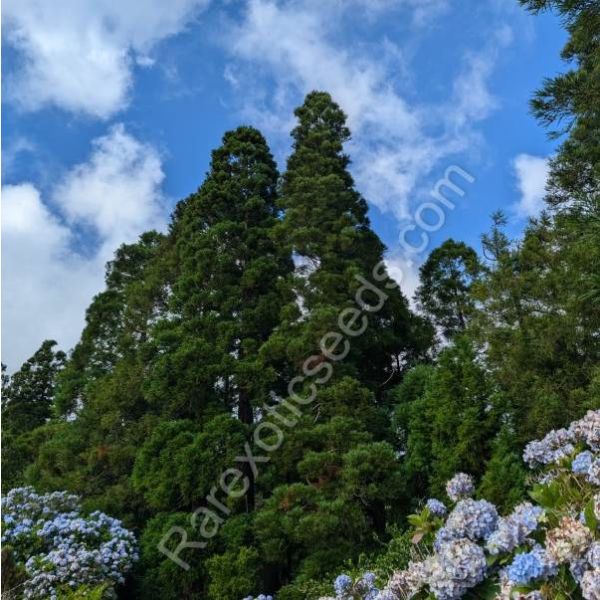Cryptomeria Japonica Seeds (Wild Japanese Cedar Seeds)
Cryptomeria Japonica Seeds (Wild Japanese Cedar Seeds)
Sugi, as it is called in Japan, has been cultivated as an ornamental for centuries. The stately Japanese cedar makes an imposing specimen.

Delivery
All orders shipped with UPS Express.
Always free shipping for orders over US $250.
All orders are shipped with a UPS tracking number.
Returns
Items returned within 14 days of their original shipment date in same as new condition will be eligible for a full refund or store credit.
Refunds will be charged back to the original form of payment used for purchase.
Customer is responsible for shipping charges when making returns and shipping/handling fees of original purchase is non-refundable.
All sale items are final purchases.
Help
Give us a shout if you have any other questions and/or concerns.
Email: contact@domain.com
Phone: +1 (23) 456 789
Availability: In stock
SKU
Cryptomeria Japonica
Cryptomeria Japonica is better known as Japanese cedar, or sugi, and belongs to the Taxodiaceae (bald-cypress family). The wild Japanese cedar is a forest tree, native to Japan and southern China.
Sugi, as it is called in Japan, has been cultivated as an ornamental for centuries. The stately Japanese cedar makes an imposing specimen. Use them in a group to create a visual screen or windbreak. The Japanese cedars, symmetrical and uniform, are often planted along avenues. The smaller, shrubby cultivars are useful accent plants or anchors in mixed borders. Japanese cedar is highly prized for bonsai, and this pseudo-cedar is one of the favourite for its small needles.
Japanese cedar is a tall, cone-shaped evergreen with bluish green foliage and a massive trunk with thick reddish brown bark that shreds and peels in long strips. This is a fast-growing tree that, in its native habitat, can get more than 180' tall with a trunk diameter exceeding 12', but ornamental specimens are rarely more than 60' tall, though, and many of the named selections stay much smaller.
The reddish brown bark is ornamental, peeling off in long strips, and is the most pronounced characteristic on old trees. The branches are arranged in horizontal tiers, ascending at first, and then drooping near their ends.
The flattened, wedge-shaped leaves are about a half-inch long and point forward, while their bases clasp the twigs. The leaves are overlapping and crowded in 5 ranks that spiral around and completely cloak the twigs. The needles will turn bronze in winter but come back to green once spring awakens.
The Sugi tree blooms from February to March. The flowers are monoecious (individual flowers are either male or female, but both sexes can be found on the same plant) and are pollinated by the wind. The seeds ripen from October to March.
Hardiness zones :
6-9 (-20c/-5f, -5c/25f). In zones 6 and 7, expect the foliage to turn brown or purplish in winter. The Cryptomeria Japonica will grow well in any moist soil, even an acidic one, but it cannot grow in the shade. Japanese cedar needs well-drained soil but plenty of water for best growth. Never allow the soil to dry out and mist if the humidity stays very low. The best stands grow on the lower slopes of mountains where annual rainfall is high. This tree can tolerate strong winds but not maritime exposure.
Japanese cedar is one of very few conifers that will coppice (sprout back from cut stumps). You can regenerate an old specimen by cutting back the trunk to 2-3' above ground, then selecting which sprout(s) to keep and which to cut. When they get too tall, cut them back and let them start over!
| Common name | Wild Japanese Cedar |
|---|---|
| Family | Taxodiaceae |
| Genus | Cryptomeria |
| Species | Cryptomeria Japonica |
| Germination | The seed germinates better if given a short cold stratification for 2 - 3 weeks at 4øc and is then placed in a warm position. Germination usually takes place within 3 - 9 weeks at 15øc. When they are large enough to handle, prick the seedlings out into individual pots and grow them on in the greenhouse for at least their first winter. Plant them out into their permanent positions in late spring or early summer, after the last expected frosts. An alternative is to plant out the young trees into an outdoor nursery bed when they are about 8cm tall and grow them on for a couple of years before planting them into their permanent positions in late autumn or early spring. |
| Price View | Price Range |

